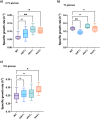The role of the SNF1 signaling pathway in the growth of Saccharomyces cerevisiae in different carbon and nitrogen sources
- PMID: 36972016
- PMCID: PMC10235354
- DOI: 10.1007/s42770-023-00954-y
The role of the SNF1 signaling pathway in the growth of Saccharomyces cerevisiae in different carbon and nitrogen sources
Abstract
Cancer is a leading cause of death worldwide, reporting nearly 10 million deaths in 2020. One of the hallmarks of cancer cells is their capability to evade growth suppressors and sustain proliferative signaling resulting in uncontrolled growth. The AMPK pathway, a catabolic via to economize ATP, has been associated with cancer. AMPK activation is related to cancer progression in advanced stages, while its activation by metformin or phenformin is associated with cancer chemoprevention. Thus, the role of the AMPK pathway in cancer growth modulation is not clear. Saccharomyces cerevisiae might be a useful model to elucidate AMPK participation in growth regulation since it shares a highly conserved AMPK pathway. Therefore, this work is aimed at evaluating the role of the AMPK pathway on S. cerevisiae growth under different nutritional conditions. Herein, we provide evidence that the SNF1 gene is necessary to maintain S. cerevisiae growth with glucose as a sole carbon source at every concentration tested. Resveratrol supplementation inhibited the exponential growth of snf1∆ strain at low glucose levels and decreased it at high glucose levels. SNF1 gene deletion impaired exponential growth in a carbohydrate concentration-dependent manner independently of nitrogen source or concentration. Interestingly, deletion of genes encoding for upstream kinases (SAK1, ELM1, and TOS3) also had a glucose dose-dependent effect upon exponential growth. Furthermore, gene deletion of regulatory subunits of the AMPK complex impacted exponential growth in a glucose-dependent manner. Altogether, these results suggest that the SNF1 pathway affects the exponential growth of S. cerevisiae in a glucose-dependent manner.
Keywords: AMPK/Snf1p; Cancer; Glucose concentration; Growth; Nitrogen sources; SNF1 signaling pathway.
© 2023. The Author(s) under exclusive licence to Sociedade Brasileira de Microbiologia.
Conflict of interest statement
The authors declare no competing interests.
Figures





Similar articles
-
Roles of the Snf1-activating kinases during nitrogen limitation and pseudohyphal differentiation in Saccharomyces cerevisiae.Eukaryot Cell. 2010 Jan;9(1):208-14. doi: 10.1128/EC.00216-09. Epub 2009 Oct 30. Eukaryot Cell. 2010. PMID: 19880754 Free PMC article.
-
Protein kinases Elm1 and Sak1 of Saccharomyces cerevisiae exerted different functions under high-glucose and heat shock stresses.Appl Microbiol Biotechnol. 2022 Mar;106(5-6):2029-2042. doi: 10.1007/s00253-022-11840-2. Epub 2022 Feb 23. Appl Microbiol Biotechnol. 2022. PMID: 35194654
-
Protein kinase A contributes to the negative control of Snf1 protein kinase in Saccharomyces cerevisiae.Eukaryot Cell. 2012 Feb;11(2):119-28. doi: 10.1128/EC.05061-11. Epub 2011 Dec 2. Eukaryot Cell. 2012. PMID: 22140226 Free PMC article.
-
SNF1/AMPK pathways in yeast.Front Biosci. 2008 Jan 1;13:2408-20. doi: 10.2741/2854. Front Biosci. 2008. PMID: 17981722 Free PMC article. Review.
-
The regulation of Saccharomyces cerevisiae Snf1 protein kinase on glucose utilization is in a glucose-dependent manner.Curr Genet. 2021 Apr;67(2):245-248. doi: 10.1007/s00294-020-01137-0. Epub 2021 Jan 1. Curr Genet. 2021. PMID: 33385241 Review.
Cited by
-
Genome-wide transcription landscape of citric acid producing Aspergillus niger in response to glucose gradient.Front Bioeng Biotechnol. 2023 Oct 24;11:1282314. doi: 10.3389/fbioe.2023.1282314. eCollection 2023. Front Bioeng Biotechnol. 2023. PMID: 37941722 Free PMC article.
References
MeSH terms
Substances
Grants and funding
LinkOut - more resources
Full Text Sources
Molecular Biology Databases

